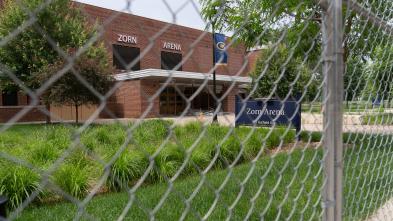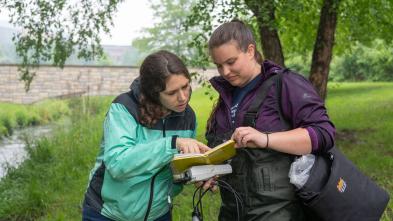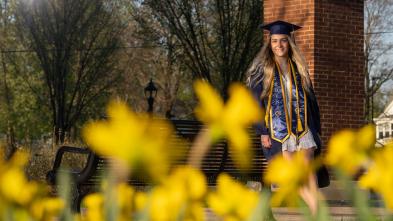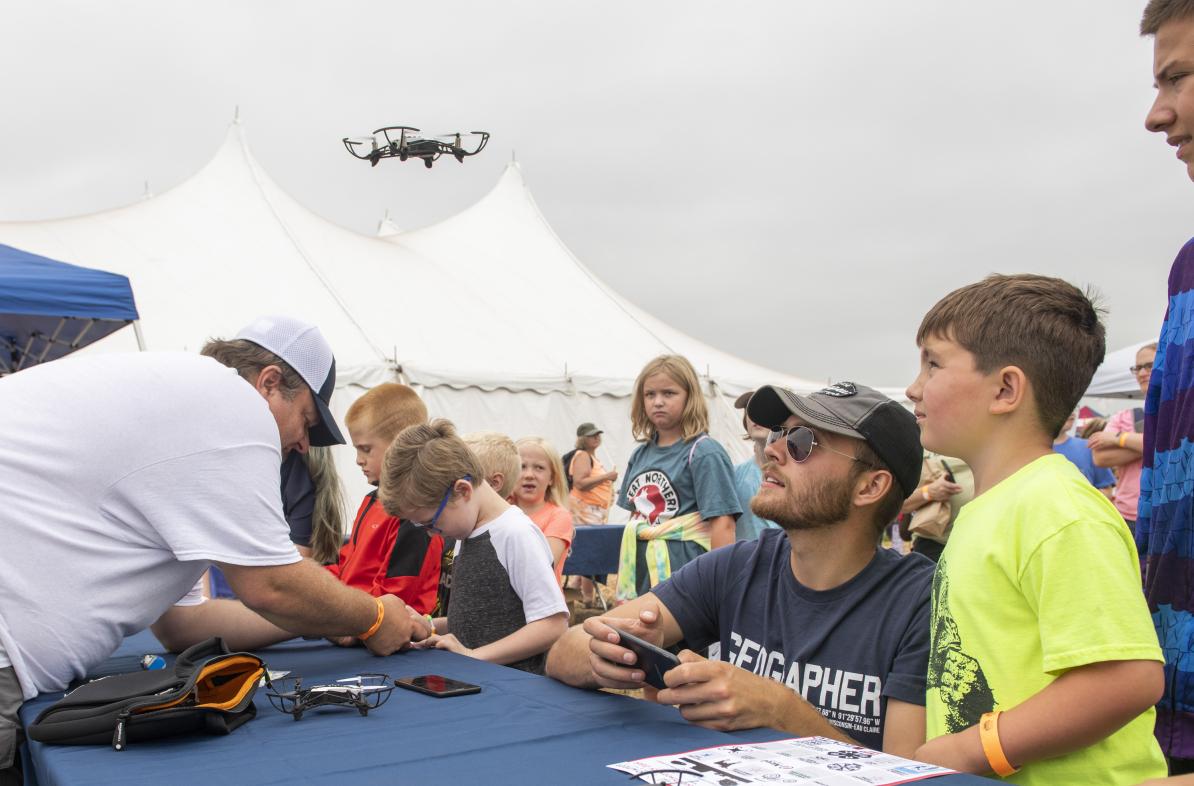
Blugold geographers and CVTC collaborate for Farm Technology Days event
In late July, Huntsinger Farms on Eau Claire’s west side welcomed more than 52,000 farmers, families and community members to the 66th Wisconsin Farm Technology Days — record-setting attendance for the annual event.
A primary attraction of the farm show was the Youth and Career Discovery Zone co-hosted by the University of Wisconsin-Eau Claire and Chippewa Valley Technical College. The event brought together CVTC technology instructors and members of UW-Eau Claire's materials science and geospatial programs, delivering a variety of STEM exploration stations and drone demonstrations to thousands of area youth and families visiting the Discovery Zone tents.
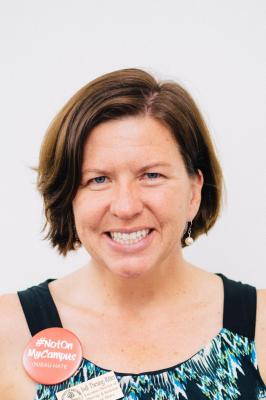
Jodi Thesing-Ritter, executive director for equity, diversity and inclusion at UW-Eau Claire and a longtime youth 4-H coordinator in the Chippewa Valley, saw a unique opportunity for collaboration when she became aware that both higher education institutions are incorporating drone use and instruction in their programs, a technology of particular interest to the agricultural industry.
“This collaboration was four years in the making and postponed by COVID-19 last summer, so it was great to finally see it all come together,” Thesing-Ritter says. “As a member of the campus community, an active leader in 4-H and other area programming that increases access to technology for youth, and as a farmer myself, this outreach event opportunity was especially meaningful.”
Adam Wehling, dean of agriculture, energy and transportation programs at CVTC, was thrilled not only at the opportunity to collaborate with Blugold faculty and students, but to present the increasingly significant role of technology like drones in area trades and industries.
“STEM continues to be a thread that ties agriculture and the trade careers together,” Wheling says. “Technology is advancing rapidly and is integrated into nearly all skilled trades. While drones may have hooked participants at Farm Technology Days, we hope the youth had a chance to discover and learn about many hands-on careers that are in high demand.”
A group effort for the community
In creating the multifaceted interactive discovery zone, Martin Goettl, UW-Eau Claire’s geospatial technology facilitator, coordinated efforts with Dr. Gary Running, professor of geography, Dr. Ryan Weichelt, associate professor of geography, and Dr. Papia Rozario, lecturer in geography and anthropology, along with Shawn Creviston, technology instructor at CVTC. Interactive stations also were allocated to the materials science and engineering department at UW-Eau Claire, coordinated by Dr. Doug Dunham, professor of materials science and engineering.
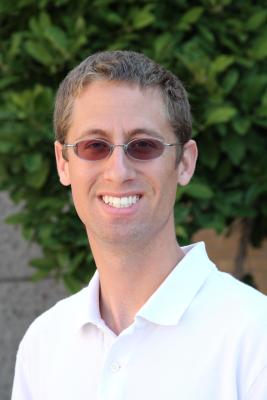
Creviston describes what became quite an elaborate drone station, combining equipment from the UW-Eau Claire and CTVC programs, including several large-screen televisions, various sized drones, video games and more.
“I had a looping video of drone footage showing on one of the TVs and multiple drones set out for display and ready to show those interested what the drones can do. We also had a farming simulator game running on the other TV for kids to play,” Creviston says. “UWEC had two tents out front with their large drones, along with another tent station setup with toy drones for kids to fly using a mobile app. The line of kids waiting to fly the little drones was nonstop for most of the three-day event.”
While the drones were indeed a huge draw to the Discovery Zone, another high-tech interactive station was the virtual reality sand table, a piece of equipment obtained by UW-Eau Claire in a grant partnership between Blugold Beginnings, the Eau Claire City-County Health Department and the geography and anthropology department at UW-Eau Claire. The table allows users to mold a landscape of sand, then simulate weather like rain and subsequent effects like runoff, demonstrating how landscapes and agriculture can be impacted by the events.
Running oversaw the visitors using the sand table, and reports that it was another successful way to demonstrate to the public how geography and area industries like agriculture intersect.
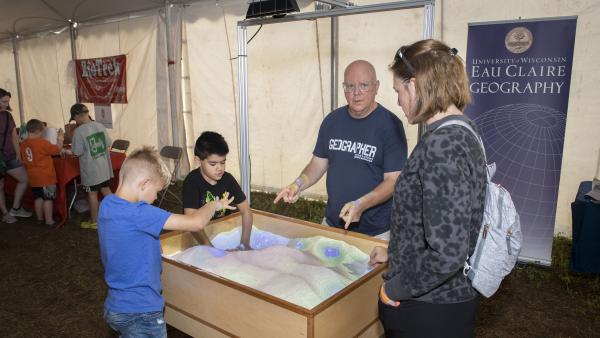
Dr. Gary Running helped kids and families attending the Farm Technology Days event to use a virtual reality sand table to simulate rain and runoff, demonstrating the impact of weather on farming.
“The sand table is just plain cool and kids love it. They also learn about contour maps and how water flows across a landscape, even if they’re just playing in the sand,” Running says. “Hands-on learning is always beneficial. The VR sand table was a hit with kids and their parents alike. Local teachers saw it in action and had many good questions and suggestions for use with kids.”
Student volunteers were key
In addition to faculty, geography research students volunteered to assist with drones, and were excited to be able to share both their knowledge and enthusiasm with young people. Nathan Moll, an environmental geography major from Stoughton who has been involved in an ongoing drone study of area farms, worked the toy drone station and enjoyed helping the kids and getting to know the project partners from CVTC.
“After flying the toy drones, many of the kids were interested in the professional drones that we had on display,” Moll says. “I think it really opened their minds to what falls under the category of geography beyond maps. Hopefully, the experience will stick with them as they get older.
“It was great to collaborate with CVTC and the people in their drone program,” he added. “Combining knowledge and resources between UWEC and CVTC is a great idea and I hope we can continue to collaborate on events and projects in the future.”

Brenna Goettl, a high school senior, was one of the geography volunteers assisting area kids wanting to learn more about flying toy drones and helping them to see the ways technology can improve critical industries like farming.
In addition to the college student volunteers, Goettl enlisted the help of his own daughters, Brenna and Brielle Goettl, who stayed very busy assisting the many kids lined up to fly the toy drones. Brenna, a senior at Eau Claire Memorial High School, was amazed at the turnout for the event.
“We could have used even more helpers for the number of kids lined up, so it got a little hectic, but seeing kids get so excited about learning to fly a drone was super rewarding,” she says.
Brielle Goettl may be only a middle school student, but she had some impressive insight about the day and the opportunity to help work with area youth, some not much younger than herself.
“The kids all reacted awesomely to the drones and had a lot of fun flying them,” she says. “It showed me that geography takes a lot of work and concentration and made me think more of pursuing my dream of being a teacher. It also made me think differently about how teachers take complex things and make them interesting and understandable for kids.”
It’s that kind of reflection that Thesing-Ritter sees as the advantages for Blugold students and even the younger volunteers like the Goettl sisters in this sort of community outreach.
“For our students, seeing the important intersections of all these elements is really valuable learning,” she says. “Even though agriculture may not be their interest, it’s so important that they make these connections between something that is their interest, like technology or geography, and see for themselves how all these lanes can and should intersect and how that impacts and improves whole communities.”
As for working with his own children for a major undertaking like this one, Goettl was grateful for the opportunity for several reasons.
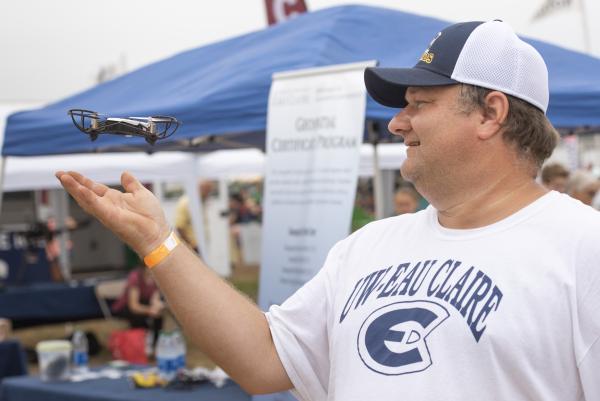
Martin Goettl, geospatial technology facilitator at UW-Eau Claire, used toy drones borrowed from the Blugold Beginnings program to demonstrate their use to thousands of kids over the three-day Farm Tech Days event.
“The success of the event reflects our hopes and dreams for the next generation of geographers, experiencing and learning at these outreach events,” Goettl says. “We want children to be excited about geography and what you can do with it, and this event provided a great opportunity to connect with them. It also gave me a valuable experience connecting with my own children through my work. It really was a family adventure for us.”
More collaboration ahead
Beyond the success of the Farm Technology Days event, future collaboration between programs at UW-Eau Claire and CTVC could be mutually beneficial, according to faculty and leadership at both institutions. As Creviston points out, the programs at the two schools complement one another.
“Each of our colleges have a drone program but use them in different ways,” Creviston says. “CVTC’s drone program focuses more on the operational side of drones. That being the regulations, controls, maintenance and learning how to fly them, whereas UWEC focuses more on the application side of what can be done with the data collected by drones. The programs overlap but each has a different end goal.”
As a UW-Eau Claire geography faculty member, Rozario sees the potential for continued partnership between the programs as a real benefit.
“We see future collaborative learning opportunities with Chippewa Valley Technical College, initially in the domain of geospatial applications in UAVs, or unmanned aerial vehicles,” she says. “Such collaborations will help develop higher-level thinking skills in students from both institutions.”
Goettl is impressed with the high-quality drone program at CVTC and says that for many reasons, collaborations between schools will continue to grow as a valued resource for student success.
Dr. Michael Carney, professor of chemistry and vice chancellor for academic affairs at UW-Eau Claire
“In the end, it is all about the students at both of our locations. If there is a better way to provide learning to students to allow them to be successful, that is what we should be doing.”
Dr. Michael Carney, associate vice chancellor for academic affairs, sees collaborative events like this one, which pulled together Blugold and CVTC students in outreach to area youth, as crucial to the mission of the university.
“We value these sorts of institutional partnerships to help educate students in the region,” Carney says. “It’s part of our institutional commitment to help meet the academic needs of all students in the region, which in turn helps address the economic needs of the state.”
You may also like
